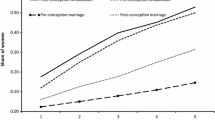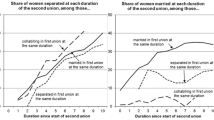Abstract
The rapid increase in the number of unmarried cohabiting couples, indicated by recent evidence, is crucial to our understanding of changing marriage patterns. The levels and patterns of entry into cohabitation have been well documented over the last two decades. but little is known about the outcomes of nonmarital cohabitation. In this study we examine two competing outcomes of cohabitation relationships: union separation and legalization of the union through marriage. Our results show that the hazard rate of union dissolution is affected particularly by gender, fertility status, partner’s marital status, religion, age at start of cohabitation, year cohabitation commenced, and region.
Similar content being viewed by others
References
Allison, P.D. 1984. Event History Analysis: Regression for Longitudinal Event Data. Beverly Hills: Sage.
Axinn, W.G. and A. Thornton. 1992. “The Relationship between Cohabitation and Divorce: Selectivity or Causal Influence?” Demography 29:357–74.
Balakrishnan, T.R., K.V. Rao, E. Lapierre-Adamcyk, and K.J. Krotki. 1987. “A Hazard Model Analysis of the Covariates of Marriage Dissolution in Canada.” Demography 24:395–406.
Becker, G.S., E.M. Landes and R.T. Michael. 1977. “An Economic Analysis of Marital Instability.” Journal of Political Economy 85:1141–87.
Bennett, N.G., A.K. Blanc and D.E. Bloom. 1988. “Commitment and the Modem Union: Assessing the Link between Premarital Cohabitation and Subsequent Marital Stability.” American Sociological Review 53:127–38.
Blanc, A.K. 1985. “The Effects of Nonmarital Cohabitation on Family Formation and Dissolution: A Comparative Analysis of Sweden and Norway.” Doctoral dissertation, Princeton University.
Bumpass, L.L., T. Castro Martin, and J.A. Sweet. 1991. “The Impact of Family Background and Early Marital Factors on Marital Disruption.” Journal of Family Issues 12:22–42.
Bumpass, L.L. and L.A. Sweet. 1989. “National Estimates of Cohabitation.” Demography 26:615–25.
Burch, T.K. and A.K. Madan. 1986. Union Formation and Dissolutions: Results from the 1984 Family History Survey. Ottawa: Statistics Canada.
Cherlin, A. 1992. Marriage, Divorce, Remarriage. Revised ed. Cambridge, MA: Harvard University Press.
Chiang, C.L. The Life Table and Its Applications. Malabar, FL: Krieger.
Cox, D.R. 1972. “Regression Models and Life Tables (with Discussion).” Journal of the Royal Statistical Society, Series B34:187–220.
Glick, P.c. and A,J. Norton. 1977. “Marrying, Divorcing and Living Together in the U.S. Today.” Population Bulletin 32.
Goldscheider, F.K. and L.J. Waite. 1986. “Sex Differences in the Entry into Marriage.” American Journal of Sociology 92:91–109.
Hill, D.H., W.G. Axinn, and A. Thornton. 1993. “Competing Hazards with Shared Unmeasured Risk Factors.” Pp. 245–77 in Sociological Methodology 1993, edited by P. Marsden. Washington DC: American Sociological Association.
Landale, N.S. and R. Forste. 1991. “Patterns of Entry into Cohabitation and Marriage among Mainland Puerto Rican Women.” Demography 28:587–607.
Lehrer, E.L. and C.U. Chiswick. 1993. “Religion as a Determinant of Marital Stability.” Demography 30:385–404.
Leridon, H. 1990. “Cohabitation, Marriage, Separation: An Analysis of Life Histories of French Cohorts from 1968 to 1985.” Population Studies 44:127–44.
Lillard, L.A. and L.J. Waite. 1993. “A Joint Model of Marital Childbearing and Marital Disruption.” Demography 30:653–81.
Lipset, S.M. 1990. Continental Divide: The Values and Institutions of the United States and Canada. New York: Routledge.
MacDonald, M.M. and R.R. Rindfuss. 1981. “Earnings, Relative Income, and Family Formation.” Demography 18:123–35.
Macklin, E. 1987. “Nontraditional Family Forms.” Pp. 237–63 in Handbook of Marriage and the Family, edited by M. Sussman and S. Steinmetz. 2nd ed. New York: Plenum Press.
Morgan, S.P., D.N. Lye, and G.A. Condran. 1988. “Sons, Daughters, and the Risk of Marital Disruption.” American Journal of Sociology 94:110–29.
Rindfuss, R.R. and A. VandenHeuvel. 1990. “Cohabitation: A Precursor to Marriage or an Alternative to Being Single?” Population Development Review 16:703–26.
Sweet, I.A. and L.L. Bumpass. 1990. “Disruption of Marital and Cohabitation Relationships: A Social-Demographic Perspective.” NSFH Working Paper 32, Center for Demographic and Ecology, University of Wisconsin, Madison.
Teachman, J.D. and K.A. Polonko. 1990. “Cohabitation and Marital Stability in the United States.” Social Forces 69:207–20.
Thornton, A. 1988. “Cohabitation and Marriage in the 1980s.” Demography 25:497–508.
Thornton, A., W.G. Axinn and D.H. Hill. 1992. “Reciprocal Effects of Religiosity, Cohabitation, and Marriage.” American Journal of Sociology 98:628–51.
Thornton, A. and D. Freedman. 1983. “The Changing American Family.” Population Bulletin 38.
Udry, J.R. 1974. Social Context of Marriage. 3rd ed. Philadelphia: Lippincott.
Waite, J.J. and L.A. Lillard. 1991. “Children and Marital Disruption.” American Journal of Sociology 96:930–53.
Wu, Z. and T.R. Balakrishnan. 1994. “Cohabitation after Marital Dissolution in Canada.” Journal of Marriage and the Family 56:723–34.
Author information
Authors and Affiliations
Additional information
The authors gratefully acknowledge the financial support from a University of Victoria faculty research grant and a research fellowship from the Center on Aging at the University of Victoria, awarded to the first author. Additional research support was provided by the Department of Sociology, the University of Victoria, and by the Department of Sociology, the University of Western Ontario. We also extend our thanks to Lynne Moffatt for research assistance, and to R. Alan Hedley, Frances K. Goldscheider and the anonymous reviewers for their many helpful comments. An early version of this paper was presented at the 1994 annual meetings of the Canadian Population Society in Calgary, Alberta, and at the 1995 annual meetings of the Population Association of America in San Francisco. Direct all correspondence to Zheng Wu, Department of Sociology, the University of Victoria, PO Box 3050 MS 7572, Victoria, BC, V8W 3P5 Canada.
Rights and permissions
About this article
Cite this article
Wu, Z., Balakrishnan, T.R. Dissolution of premarital cohabitation in Canada. Demography 32, 521–532 (1995). https://doi.org/10.2307/2061672
Issue Date:
DOI: https://doi.org/10.2307/2061672




